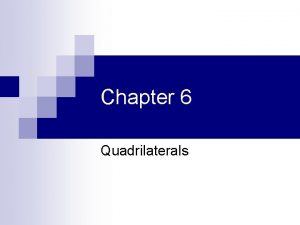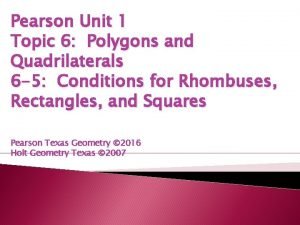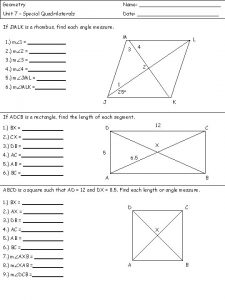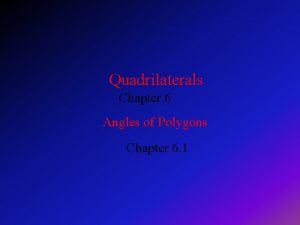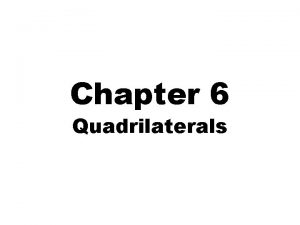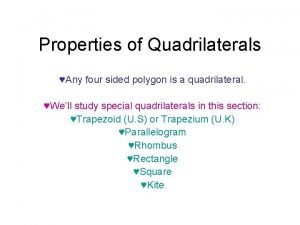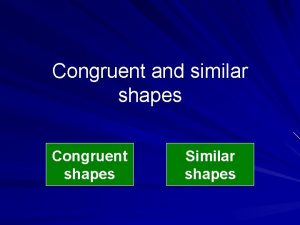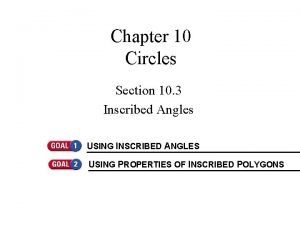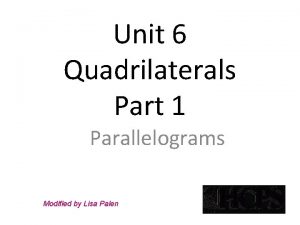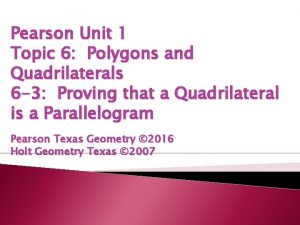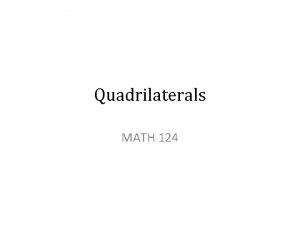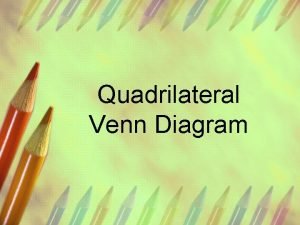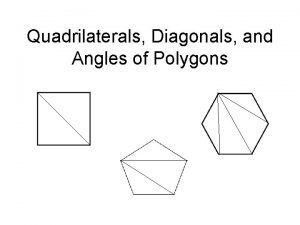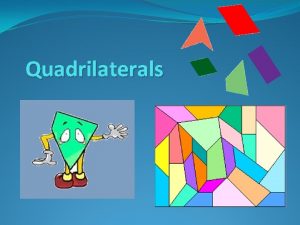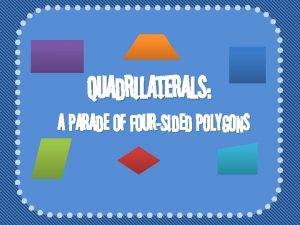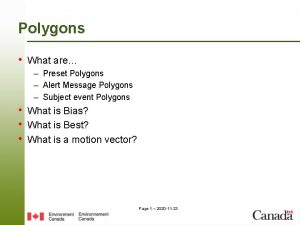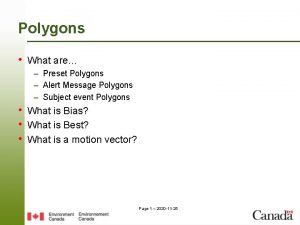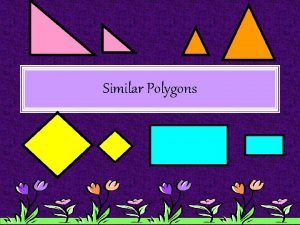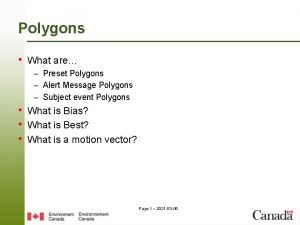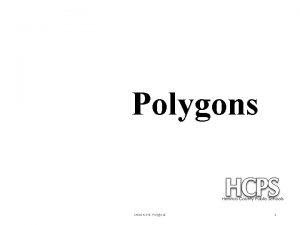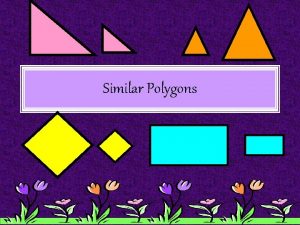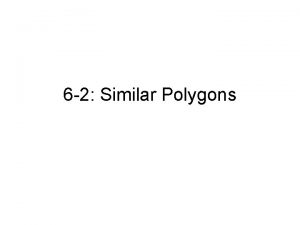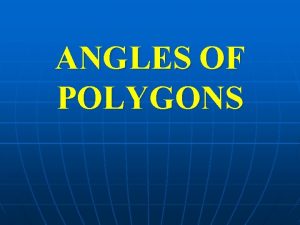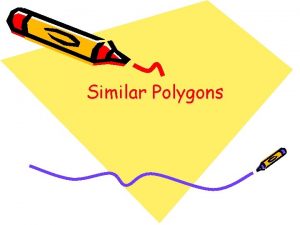Pearson Unit 1 Topic 6 Polygons and Quadrilaterals


















- Slides: 18

Pearson Unit 1 Topic 6: Polygons and Quadrilaterals 6 -4: Properties of Rhombuses, Rectangles, and Squares Pearson Texas Geometry © 2016 Holt Geometry Texas © 2007

� TEKS Focus: � (5)(A) Investigate patterns to make conjectures about geometric relationships, including angles formed by parallel lines cut by a transversal, criteria required for triangle congruence, special segments of triangles, diagonals of quadrilaterals, interior and exterior angles of polygons, and special segments and angles of circles choosing from a variety of tools. � (1)(C) Select tools, including real objects, manipulatives paper and pencil, and technology as appropriate, and techniques, including mental math, estimations, and number sense as appropriate, to solve problems. � (1)(F) Analyze mathematical relationships to connect and communicate mathematical ideas. � (6)(E) Prove a quadrilateral is a parallelogram, rectangle, square, or rhombus using opposite sides, opposite angles, or diagonals and apply these relationships to solve problems.

A second type of special quadrilateral is a rectangle. A rectangle is a quadrilateral with four right angles.

A rhombus is another special quadrilateral. A rhombus is a quadrilateral with four congruent sides.

A square is a quadrilateral with four right angles and four congruent sides. In the exercises, you will show that a square is a parallelogram, a rectangle, and a rhombus. So a square has the properties of all three.




Example: 1 Is ABCD a rhombus, rectangle or square? Explain.

Example: 2 A woodworker constructs a rectangular picture frame so that JK = 50 cm and JL = 86 cm. Find HM. Rect. diags. KM = JL = 86 Def. of segs. diags. bisect each other Substitute and simplify.

Example: 3 Carpentry: The rectangular gate has diagonal braces. Find HJ and HK. Rect. diags. HJ = GK = 48 Def. of segs. Rect. diags. Rect. diagonals bisect each other JL = LG Def. of segs. JG = 2 JL = 2(30. 8) = 61. 6 Substitute and simplify.

Example: 4 TVWX is a rhombus. Find TV. WV = XT 13 b – 9 = 3 b + 4 10 b = 13 b = 1. 3 Def. of rhombus Substitute given values. Subtract 3 b from both sides and add 9 to both sides. Divide both sides by 10. TV = XT Def. of rhombus TV = 3 b + 4 Substitute 3 b + 4 for XT. TV = 3(1. 3) + 4 = 7. 9 Substitute 1. 3 for b and simplify.

Example: 5 TVWX is a rhombus. Find m VTZ. m VZT = 90° 14 a + 20 = 90° a=5 m VTZ = m ZTX m VTZ = (5 a – 5)° m VTZ = [5(5) – 5)]° = 20° Rhombus diag. Substitute 14 a + 20 for m VTZ. Subtract 20 from both sides and divide both sides by 14. Rhombus each diag. bisects opp. s Substitute 5 a – 5 for m VTZ. Substitute 5 for a and simplify.

Example: 6 CDFG is a rhombus. Find CD. CG = GF Def. of rhombus 5 a = 3 a + 17 Substitute a = 8. 5 Simplify GF = 3 a + 17 = 42. 5 Substitute CD = GF Def. of rhombus CD = 42. 5 Substitute

Example: 7 CDFG is a rhombus. Find m GCH if m GCD = (b + 3)° and m CDF = (6 b – 40)° m GCD + m CDF = 180° b + 3 + 6 b – 40 = 180° 7 b = 217° b = 31° Def. of rhombus Substitute. Simplify. Divide both sides by 7.

Example: 7 continued m GCH + m HCD = m GCD 2 m GCH = m GCD Rhombus each diag. bisects opp. s 2 m GCH = (b + 3) Substitute. 2 m GCH = (31 + 3) m GCH = 17° Substitute. Simplify and divide both sides by 2.

Example: 8 A carpenter’s square can be used to test that an angle is a right angle. How could the contractor use a carpenter’s square to check that the frame is a rectangle? 12 feet 8 ft 12 feet Both pairs of opp. sides of WXYZ are , so WXYZ is a parallelogram. The contractor can use the carpenter’s square to see if one of WXYZ is a right . If one angle is a right , then by Theorem 6 -5 -1 the frame is a rectangle.

 Topic 6 quadrilaterals and other polygons answers
Topic 6 quadrilaterals and other polygons answers Topic 6 quadrilaterals and other polygons answers
Topic 6 quadrilaterals and other polygons answers Unit 7 polygons and quadrilaterals
Unit 7 polygons and quadrilaterals Find the measure of each interior angle.
Find the measure of each interior angle. Chapter 6 quadrilaterals
Chapter 6 quadrilaterals All quadrilaterals are polygons true or false
All quadrilaterals are polygons true or false Area of four sided polygon
Area of four sided polygon Similar shapes and proportions lesson 4-1
Similar shapes and proportions lesson 4-1 Unit 10 circles inscribed angles
Unit 10 circles inscribed angles Painted paragraph strategy
Painted paragraph strategy Broad and specific topic examples
Broad and specific topic examples Unit 3 quadrilaterals and coordinate proof
Unit 3 quadrilaterals and coordinate proof Proving the parallelogram side theorem
Proving the parallelogram side theorem Rhombus
Rhombus Pearson education inc. publishing as prentice hall
Pearson education inc. publishing as prentice hall Pearson education 2011
Pearson education 2011 Bob whelan pearson
Bob whelan pearson Stress management for life 5th edition
Stress management for life 5th edition Pearson education inc publishing as pearson prentice hall
Pearson education inc publishing as pearson prentice hall
